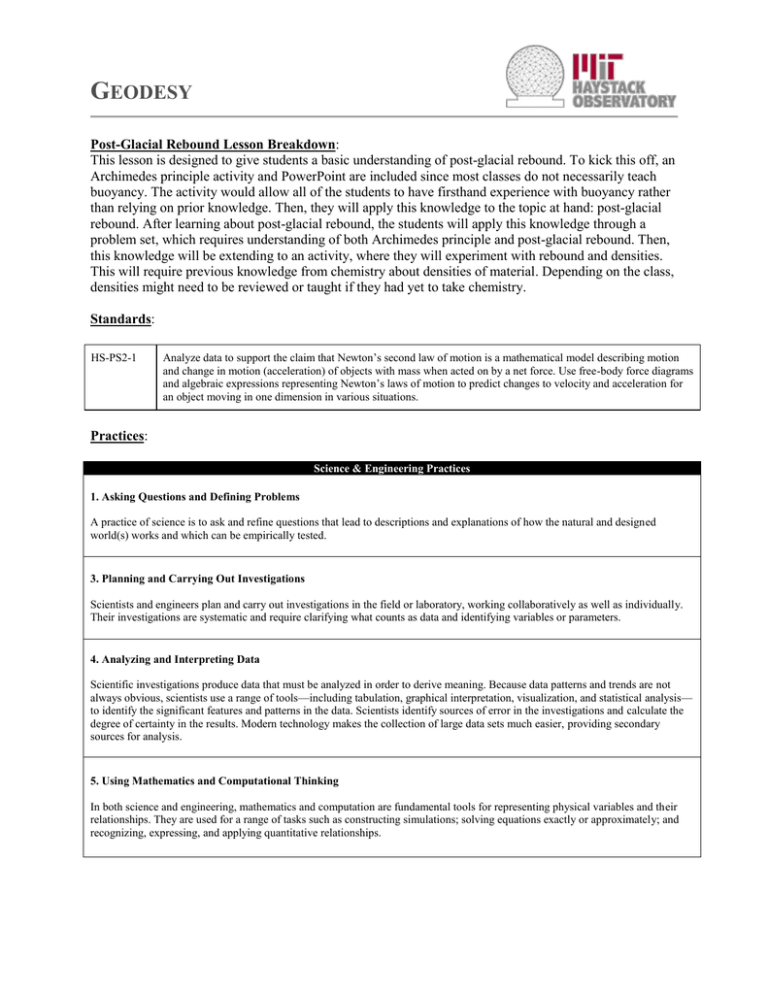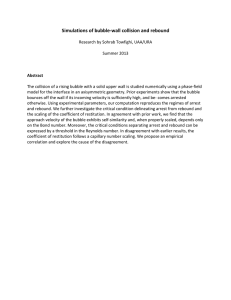G EODESY
advertisement

GEODESY Post-Glacial Rebound Lesson Breakdown: This lesson is designed to give students a basic understanding of post-glacial rebound. To kick this off, an Archimedes principle activity and PowerPoint are included since most classes do not necessarily teach buoyancy. The activity would allow all of the students to have firsthand experience with buoyancy rather than relying on prior knowledge. Then, they will apply this knowledge to the topic at hand: post-glacial rebound. After learning about post-glacial rebound, the students will apply this knowledge through a problem set, which requires understanding of both Archimedes principle and post-glacial rebound. Then, this knowledge will be extending to an activity, where they will experiment with rebound and densities. This will require previous knowledge from chemistry about densities of material. Depending on the class, densities might need to be reviewed or taught if they had yet to take chemistry. Standards: HS-PS2-1 Analyze data to support the claim that Newton’s second law of motion is a mathematical model describing motion and change in motion (acceleration) of objects with mass when acted on by a net force. Use free-body force diagrams and algebraic expressions representing Newton’s laws of motion to predict changes to velocity and acceleration for an object moving in one dimension in various situations. Practices: Science & Engineering Practices 1. Asking Questions and Defining Problems A practice of science is to ask and refine questions that lead to descriptions and explanations of how the natural and designed world(s) works and which can be empirically tested. 3. Planning and Carrying Out Investigations Scientists and engineers plan and carry out investigations in the field or laboratory, working collaboratively as well as individually. Their investigations are systematic and require clarifying what counts as data and identifying variables or parameters. 4. Analyzing and Interpreting Data Scientific investigations produce data that must be analyzed in order to derive meaning. Because data patterns and trends are not always obvious, scientists use a range of tools—including tabulation, graphical interpretation, visualization, and statistical analysis— to identify the significant features and patterns in the data. Scientists identify sources of error in the investigations and calculate the degree of certainty in the results. Modern technology makes the collection of large data sets much easier, providing secondary sources for analysis. 5. Using Mathematics and Computational Thinking In both science and engineering, mathematics and computation are fundamental tools for representing physical variables and their relationships. They are used for a range of tasks such as constructing simulations; solving equations exactly or approximately; and recognizing, expressing, and applying quantitative relationships. GEODESY 6. Constructing Explanations and Designing Solutions The end-products of science are explanations and the end-products of engineering are solutions. The goal of science is the construction of theories that provide explanatory accounts of the world. A theory becomes accepted when it has multiple lines of empirical evidence and greater explanatory power of phenomena than previous theories. 7. Engaging in Argument from Evidence Argumentation is the process by which evidence-based conclusions and solutions are reached. In science and engineering, reasoning and argument based on evidence are essential to identifying the best explanation for a natural phenomenon or the best solution to a design problem. Scientists and engineers use argumentation to listen to, compare, and evaluate competing ideas and methods based on merits. Scientists and engineers engage in argumentation when investigating a phenomenon, testing a design solution, resolving questions about measurements, building data models, and using evidence to evaluate claims. English Language Learners’ Accommodations - Pre-teach vocabulary o Definitions I tried to tier the words used in this lesson: Tier 1 words Tier 2 words Tier 3 words Object, ice, temperature Force, weight, displace, sheets, period, depress, mantle, pressure, plate Submerge, fluid, buoyant, glacial, deform, crust, dissipate - Graphic Organizer by Holt o Using the Cluster Diagram created by Holt, I placed three words carefully in the diagram: density, pressure, and buoyancy. This can be done with only ELLs and with the whole class. It acts as a review of the concepts and describes how they are connected. My goal is to have students connect all three terms to force. The last cluster is left blank that way students have the chance to come up with another term that is relevant. Furthermore, I encouraged students to draw connecting lines if other terms are relevant between two of the three given words. On the next page, I included Holt’s Cluster Diagram that I have used. In red, I have included possible terms that my students have come up with. Support: - Videos: o Buoyancy and Density - https://www.youtube.com/watch?v=VDSYXmvjg6M o Introduction to Buoyancy - https://www.youtube.com/watch?v=sUjDUW_08Ms - Demonstrations / Labs/Simulations: o https://phet.colorado.edu/en/simulation/density o https://phet.colorado.edu/en/simulation/legacy/buoyancy GEODESY Citations: Beauregard, Mike. Rebounding Beach, among Other Things. Digital image. Wikimedia Commons. Web. <https://commons.wikimedia.org/wiki/File:Rebounding_beach,_among_other_things_( 9404384095).jpg>. Holt. "Graphic Design." SpringerReference (2011): n. pag. Graphic Organizer - Cluster Diagram. Holt. Web. <http://my.hrw.com/nsmedia/intgos/html/PDFs/Cluster_Diagram.pdf>. Kentynet. A map of post-glacial rebound effects on the British Isles, namely whether areas of land are rising, sinking or are stable. Digital image. Wikipedia. Web. <https://en.wikipedia.org/wiki/File:Post-glacial_rebound_in_British_Isles.PNG>. Xkcd. Xkcd: Ice Sheets. Digital image. Xkcd: Ice Sheets. Web. <http://xkcd.com/1225/>. GEODESY NAME CLASS DATE Graphic Organizer Cluster Diagram Mass Volume Area Density Pressure Force Buoyancy Fluid Float Copyright © by Holt, Rinehart and Winston. All rights reserved.





